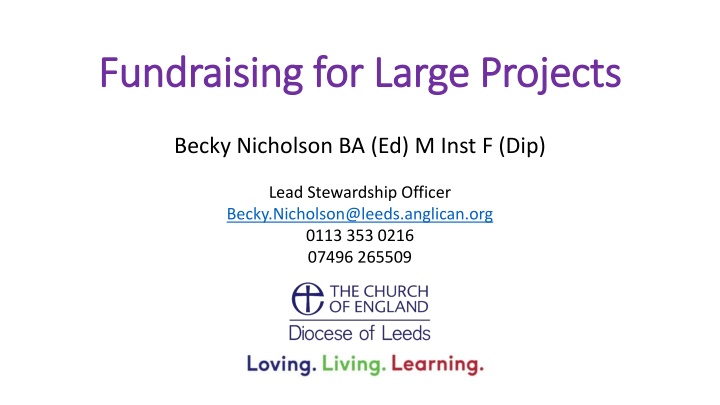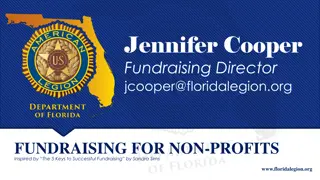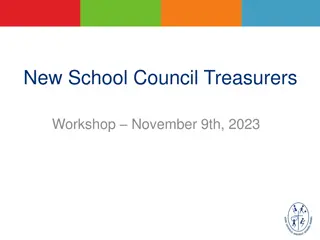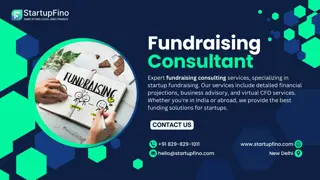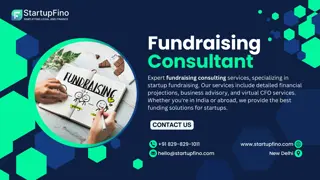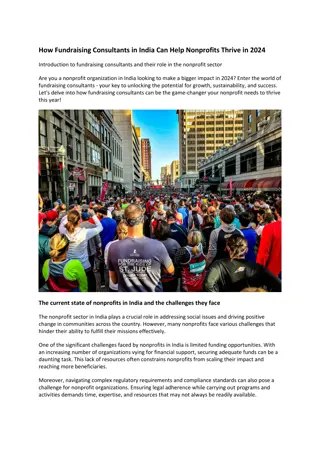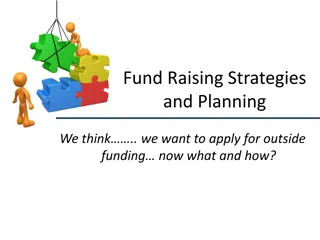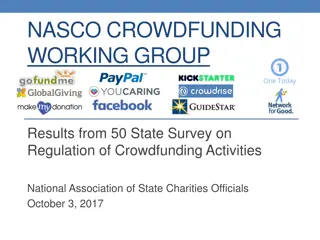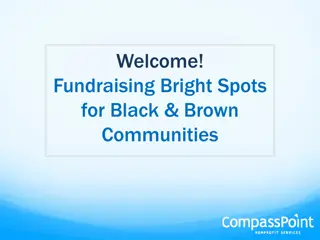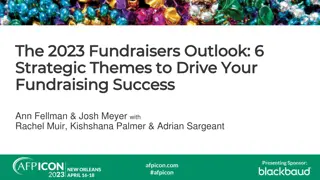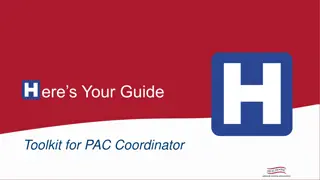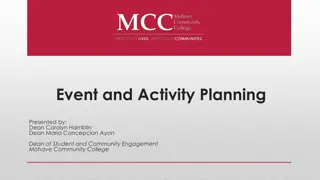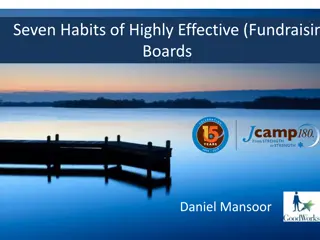Fundraising for Large Projects
This content covers various phases in fundraising projects, including feasibility, preparatory, private, public, and completion phases. It also delves into preparatory phase strategies such as identifying big investors, grants, and community events, along with creating tactical plans and engaging with potential funders.
Download Presentation

Please find below an Image/Link to download the presentation.
The content on the website is provided AS IS for your information and personal use only. It may not be sold, licensed, or shared on other websites without obtaining consent from the author.If you encounter any issues during the download, it is possible that the publisher has removed the file from their server.
You are allowed to download the files provided on this website for personal or commercial use, subject to the condition that they are used lawfully. All files are the property of their respective owners.
The content on the website is provided AS IS for your information and personal use only. It may not be sold, licensed, or shared on other websites without obtaining consent from the author.
E N D
Presentation Transcript
Fundraising for Large Projects Fundraising for Large Projects Becky Nicholson BA (Ed) M Inst F (Dip) Lead Stewardship Officer Becky.Nicholson@leeds.anglican.org 0113 353 0216 07496 265509
Capital Campaign Fundraising Capital Campaign Fundraising not Simply Fundraising! Fundraising! not Simply A coordinated institutional effort, with a specified goal and timetable, to increase an organisation s permanent assets a building, a significant expansion of programme, endowment, or a combination of these that will lift the organisation to a higher level of performance. Trudi Hayden Capital Campaigns Directory of Social Change 2006
Fundraising Phases of a Project Fundraising Phases of a Project Feasibility Phase Preparatory Phase Private Phase Public Phase Completion Phase
Feasibility Phase Feasibility Phase Involvement of the Archdeacon and DAC Consulted all stakeholders Church viability Consultation with surveyors and architects Fundraising team
Preparatory Phase Preparatory Phase Gift Table Number of Gifts Amount Total 1 40,000 40,000 2 20,000 40,000 3 5,000 15,000 8 1,000 8,000 10 500 5000 40 100 4000 Many < 50 5000+ Target Total 117,000
Preparatory Phase Preparatory Phase Strategy Identify big investors and grants first Community events Smaller gifts Write a tactical plan.
Preparatory Phase Preparatory Phase - - Tactical Plan Tactical Plan - - Grants Grants Objective Action Measure Who is responsible Budget 1.Identify the funders who will support our project 1a.Speak to stewardship team at Diocese. 1b.Access www.fundsonline.co.uk 1a. Advice sought and taken by June 2020 1b.Potential funders identified by June 2020 1a.Bob and Jill 1b.Bob and Jill Training travel cost 20 2.Write a case for support 2a.Gather all documentation together 2b.Arrange meetings for drafting the CFS 2c.Create different CFS for different audiences/leaflets/posters 2a.Documentation gathered by July 2020 2b.Meetings conducted Sept 2020 2c.Impactful and compelling CFS written by Sept 2020 2a.Sue and Phil 2b.Bob, Jill, Sue, Phil 2c.Sue and Phil ect
Preparatory Phase Preparatory Phase Case for Support Who are you and what do you do? What is distinctive about you? What must be accomplished need? How will funding solve the need? Why should the donor be involved How will donors benefit?
Private Phase Private Phase Approach lead prospects Write grant applications Take information from the Case for Support Table of contents Executive summary A statement of need Project objectives and description Evaluation processes
Private Phase Private Phase Grant applications (continued) Expertise available Future plans and sustainability Budget Additional support Appendices
How can I have the best chance of success? Two thirds of all applications do not fit the eligibility criteria. Of all those that do fit the criteria only 40% are approved for funding WHY? No coordination with other projects in the field Proposal poorly written and hard to understand Not enough evidence that the project will be carried out Client group not involved in planning No evidence of sustainability Evaluation procedure is inadequate Project has low interest Objectives too ambitious Source: Indiana University Centre on Philanthropy Not following application guidelines Project poorly documented
Public Phase Public Phase Advertise far and wide Give a range of donation opportunities Keep momentum
Completion Phase Completion Phase Collect all donations and pledges Keep everyone informed with how the project is progressing Follow evaluation procedures Finally celebrate success and say thank you to each and every one of your supporters Give thanks to God
